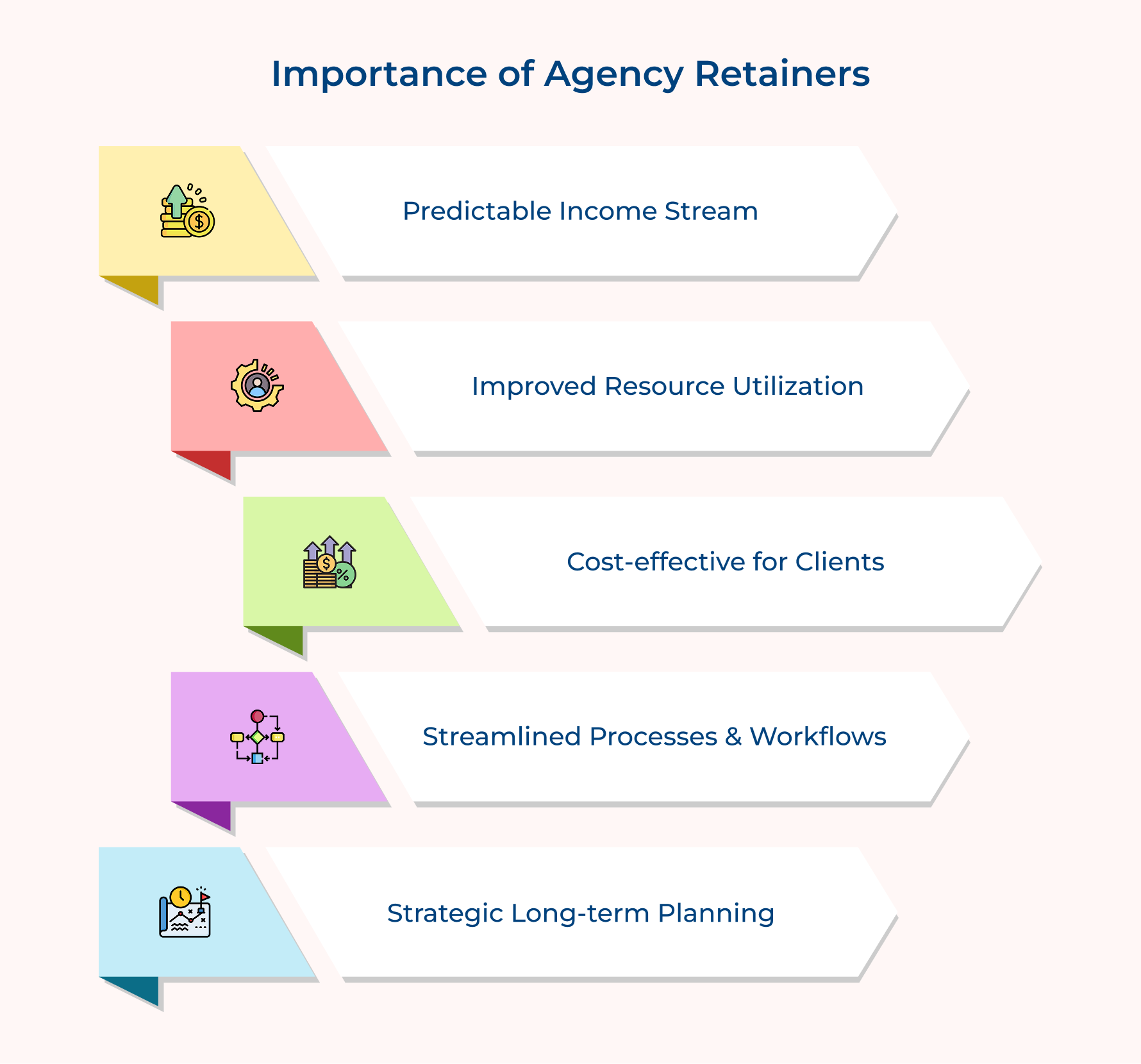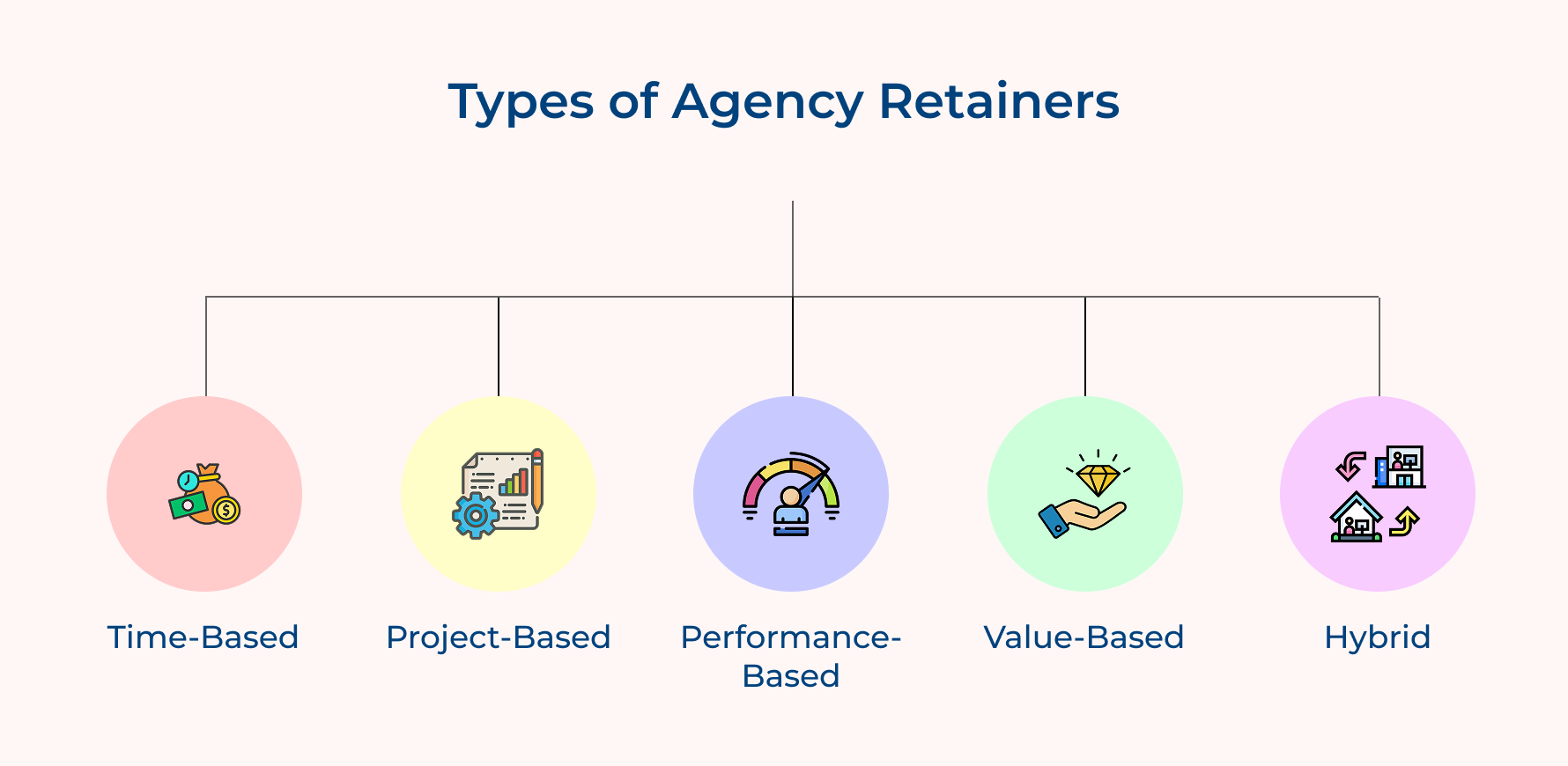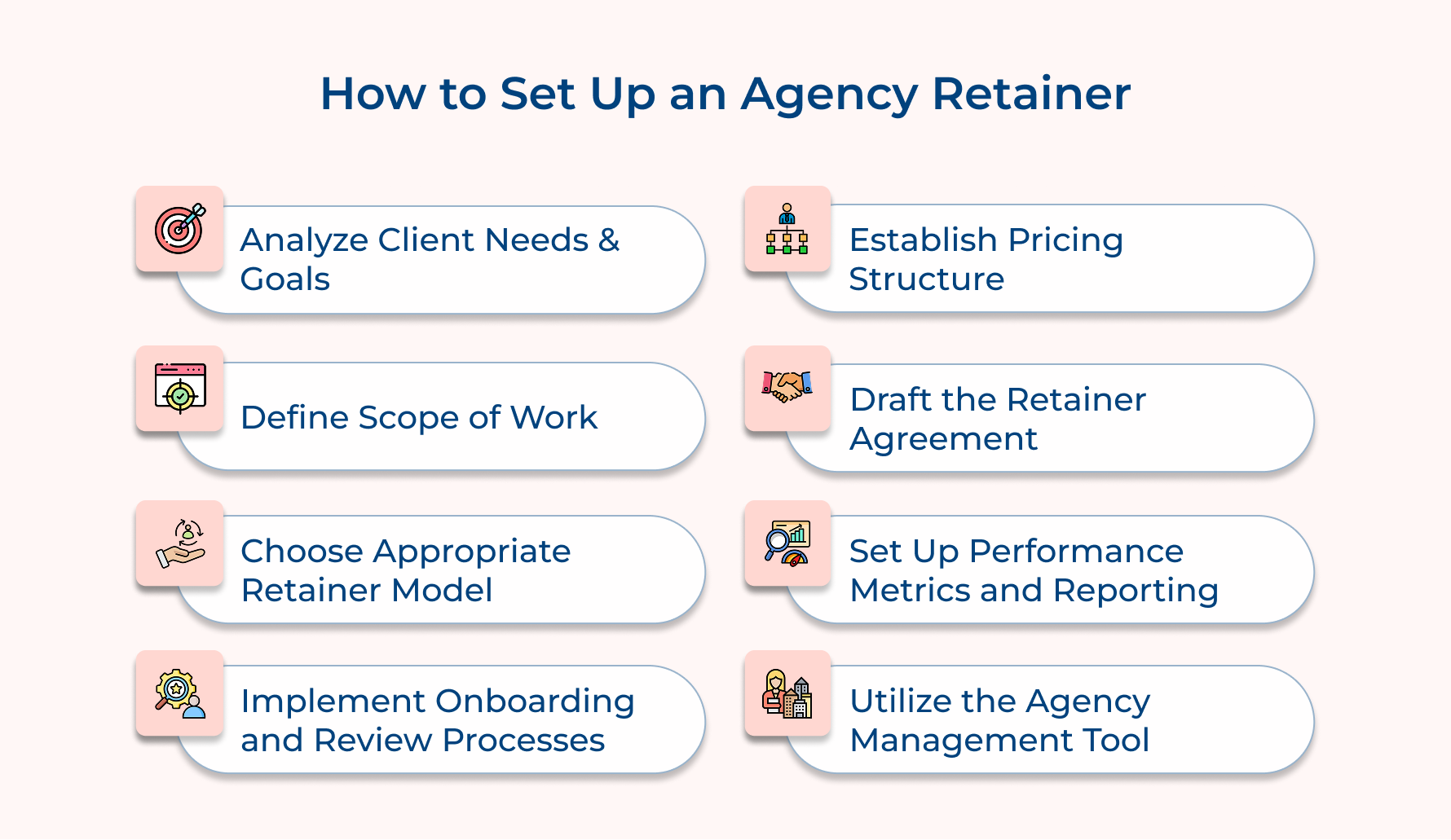Why Agency Retainers are Crucial to Long-Term Client Success

Key Highlights
Running an agency means constantly searching for new clients or finding ways to retain existing ones—no easy feat. Agency retainers offer a solution, shifting from project-based work to building long-term partnerships.
Retainers benefit both sides: clients enjoy consistent support, and agencies gain predictable revenue as well as deeper insights into client needs. This model creates stability and collaboration, making it a win-win.
Let’s explore how retainers work, their benefits, and why they could be a game-changer for agencies and clients alike.
What is an Agency Retainer?
An agency retainer is a contractual agreement between a client and a service provider (such as an agency, consultancy, or professional services firm) in which the client pays a fixed fee in advance for a predetermined amount of work or services over a set period, typically monthly or quarterly. The arrangement ensures that the service provider reserves a portion of their time and resources for the client’s ongoing needs.
Retainer agreements provide a stable income stream for agencies and professional services firms, allowing them to better financial planning as well as resource allocation. Retainers build long-term relationships with clients.
Enabling service providers to gain a comprehensive understanding of the client’s business is also benefiting clients because they are assured of priority access to the agency’s resources.
Key objectives:
- Establish a consistent revenue stream for the service provider while offering value and predictability to the client.
- Ensure resource availability as well as priority service for the client’s ongoing needs.
- Create a framework for efficient workflow management and continuous improvement in service delivery.
Importance of Agency Retainers
Agency retainers are like a trusted partnership, offering consistent support and expertise without the hassle of constant back-and-forth contracts. Let’s explore why else is it important.
Predictable Income Stream
Agency retainers provide a stable, recurring revenue source. This financial predictability allows agencies to better manage cash flow, growth plans, and invest in resources with confidence. It reduces the feast-or-famine cycle common in project-based work, creating a more sustainable business model.
Improved Resource Utilization
With retainers, agencies can allocate staff more efficiently. The consistent workload enables better planning and utilization of team members’ skills, reducing idle time while improving overall productivity.
Cost-effective for Clients
Retainers often offer clients better value for money compared to ad-hoc projects. They typically receive priority service and can benefit from economies of scale, as the agency becomes more efficient in handling their needs over time.
Streamlined Processes & Workflows
Long-term engagements allow agencies to develop tailored workflows and processes for each client. It increases efficiency, faster turnaround times, and higher-quality outputs as the team becomes intimately familiar with the client’s business.
Strategic Long-term Planning
Retainers build deeper client relationships, enabling agencies to develop comprehensive, long-term strategies. The strategic approach often leads to better results as agencies can plan and execute cohesive campaigns over extended periods, rather than focusing on short-term, disconnected projects.
Types of Agency Retainers
There is a wide range of agency retainers, each designed to meet specific client needs and agency capabilities. Choose the right type of retainer that best suits your agency’s needs.
1. Time-based Retainers: These are monthly retainers that allocate a set number of hours or days per month. Clients pay for a predetermined amount of time, regardless of the specific tasks completed. The model works well for ongoing projects or general support needs.
2. Project-based Retainers: In this arrangement, the agency commits to delivering specific projects or outputs within the retainer period. This type is ideal for clients with recurring project needs, such as monthly content creation or regular marketing campaigns.
3. Performance-based Retainers: They tie compensation to agreed-upon metrics or key performance indicators (KPIs). As the agency achieves or exceeds targets, it may earn additional fees. It aligns agency incentives with client goals which helps you gain future services too.
4. Value-based Retainers: Rather than focusing on specific deliverables or periods, these retainers are structured around the value provided to the client. Pricing is based on the potential impact or results of the agency’s work.
5. Hybrid Retainers: They combine elements of different retainer types to create a customized arrangement. For example, a retainer might include a base fee for core services plus performance bonuses. The hybrid style improves retainer relationships between the agency and the client.
How to Set Up an Agency Retainer
1. Analyze Client Needs & Goals
Understanding client needs and goals is crucial for tailoring the retainer agreement to their specific requirements. The step ensures that the agency can provide relevant, valuable services that align with the client’s business objectives, creating a mutually beneficial long-term relationship.
Conduct in-depth discovery sessions with the client to gather information about their industry, challenges, and aspirations. Use this insight to shape the retainer proposal, ensuring it addresses the client’s pain points as well as supports their growth strategies.
Actionable tips:
- Develop a comprehensive client questionnaire covering business goals, target audience, competitors, and current marketing efforts. Use it as a foundation for your discovery sessions.
- Create a SWOT (Strengths, Weaknesses, Opportunities, Threats) analysis for the client’s business to identify areas where your agency can add the most value.
2. Define Scope of Work
A clearly defined scope of work sets expectations for both the agency and the client. It prevents scope creep and ensures that resources are allocated efficiently, while also providing a framework for measuring the success of the retainer agreement.
Based on the client analysis, an outline of specific services, deliverables, additional costs, and timelines will be included in the retainer. It should be a collaborative process with the client to ensure all critical needs are addressed.
Actionable tips:
- Create a detailed service menu with clear descriptions of each offering, including estimated time investments. It helps clients understand the value they’re receiving.
- Use a work breakdown structure (WBS) to organize and visualize the scope of work, making it easier for both parties to understand the full extent of the engagement.
3. Choose the Appropriate Retainer Model
Selecting the right retainer model ensures that the agreement structure aligns with the client’s needs and the agency’s capabilities. It affects pricing, resource allocation, and overall client satisfaction.
Evaluate different retainer models (e.g., time-based, project-based, performance-based) against the client’s requirements as well as your agency’s strengths. Choose the model that offers the best fit and potential for success.
Actionable tips:
- Create a comparison chart of different retainer models, highlighting the pros and cons of your specific client scenario.
- Consider offering a hybrid model that combines elements of different retainer types to provide a customized solution for complex client needs.
4. Establish Pricing Structure
A well-thought-out pricing structure ensures that the agency is fairly compensated for its work while providing value to the client. It’s crucial for the financial health of the agency and the sustainability of the client relationship.
Calculate your costs, including overhead and desired profit margin. Consider value-based pricing strategies that tie fees to the impact of your work (mention hourly rate if you find it necessary). Ensure the pricing structure is transparent and easy for the client to understand.
Actionable tips:
- Develop a tiered pricing model that allows clients to choose from different levels of service, making it easier to upsell or adjust the retainer as needs change.
- Include a clause for periodic price reviews to account for inflation and increased value delivery as the relationship matures.
5. Draft the Retainer Agreement
A comprehensive retainer agreement protects both parties by clearly outlining expectations, deliverables, and terms. It serves as a reference point throughout the engagement and helps prevent misunderstandings.
Create a detailed contract that covers all aspects of the retainer that include scope of work, payment terms, confidentiality and termination clauses. Ensure it’s reviewed by legal counsel before presentation.
Actionable tips:
- Include a clear process for requesting additional work outside the retainer scope, including how it will be priced and approved.
- Add a clause that allows for flexibility in reallocating unused retainer hours or budget to other services, providing added value to the client.
6. Set Up Performance Metrics and Reporting
Establishing clear performance metrics and reporting processes demonstrates the value of your agency’s work. It provides accountability, helps track progress toward goals, and informs strategic decisions.
Define key performance indicators (KPIs) that align with the client’s business objectives. Set up regular reporting schedules as well as create templates that communicate progress, challenges, and recommendations.
Actionable tips:
- Implement a dashboard tool that provides real-time access to KPIs, allowing both the agency and client to monitor progress continuously.
- Schedule monthly strategy meetings to review performance reports, discuss insights, and adjust tactics as needed to ensure optimal results.
7. Implement Onboarding and Review Processes
A smooth onboarding process sets the tone for the entire engagement, while regular reviews ensure ongoing alignment and satisfaction. These processes are crucial for building trust and maintaining a strong client relationship.
Develop a structured onboarding program that introduces the client to your team, tools, and processes. Establish a schedule for periodic reviews to assess the retainer’s effectiveness and make necessary adjustments.
Actionable tips:
- Create a welcome packet for new retainer clients, including team bios, communication protocols, and a roadmap for the first 90 days of the engagement.
- Conduct quarterly business reviews to assess the retainer’s performance against goals, discuss upcoming objectives, and identify opportunities for added value.
8. Utilize The Agency Management Tool
Efficient agency management tools like Kooper streamline operations, improve resource allocation, and provide valuable insights into project profitability. They’re essential for managing retainers effectively and scaling your agency.
Implement Kooper to track time, manage projects, monitor budgets, and generate reports for ongoing services. Use its features to automate invoicing, forecast resource needs, and analyze the profitability of your retainer agreements.
Actionable tips:
- Set up custom workflows in Kooper that align with your retainer processes, ensuring consistency in service delivery across all client accounts.
- Utilize the tool’s reporting features to create automated monthly client reports, saving time and providing consistent, professional updates.
What to Include in an Agency Retainer Agreement?
A well-crafted retainer agreement protects both parties and provides a solid foundation for a successful long-term partnership. It’s advisable to have the agreement reviewed by legal counsel to ensure it’s comprehensive and compliant with relevant laws.
1. Scope of Services
Clearly define the specific services covered under the retainer. List deliverables, timelines, and any limitations. Be explicit about what is and isn’t included to prevent misunderstandings as well as scope creep.
2. Duration and Renewal Terms
Specify the length of the retainer agreement (e.g., 6 months, 1 year) and outline the process for renewal. Include details on how either party can terminate the agreement and any notice periods required.
3. Fees and Payment Schedule
Detail the retainer fee amount, payment frequency (e.g., monthly, quarterly), and accepted payment methods. Include clauses for late payments, including any interest or penalties.
4. Resource Allocation
Outline the resources (e.g., staff hours, specific team members) allocated to the client under the retainer. Specify how unused hours or resources are handled (e.g., rollover policy, expiration).
5. Performance Metrics and Reporting
Define key performance indicators (KPIs) and how success will be measured. Establish a regular reporting schedule as well as specify the format and content of these reports.
6. Communication Protocols
Set expectations for communication frequency, preferred channels, and response times. Specify primary points of contact on both sides and any scheduled check-ins or meetings.
7. Intellectual Property (IP) Rights
Clarify ownership of work produced under the retainer. Address any licensing agreements or usage rights for materials created during the engagement.
8. Confidentiality and Non-Disclosure
Include clauses protecting both parties’ confidential information. Specify how sensitive data will be handled and any restrictions on sharing information.
Additional considerations:
- Process for requesting work outside the retainer scope
- Clause for adjusting the retainer terms if needs change significantly
- Details on how disputes will be resolved
- Any performance-based incentives or bonuses
- Specifics on agency and client responsibilities
Empowering Agencies Through Strategic Retainer Practices
Agency retainer management is essential for maintaining long-term client relationships and ensuring stable revenue streams. Establishing clear terms and expectations builds trust as well as collaboration, while a well-structured retainer agreement clarifies the scope of work, deliverables, and payment schedules.
Effective management requires regular communication and performance tracking. Agencies should assess client satisfaction and project outcomes frequently to adapt their strategies accordingly. A proactive approach strengthens client loyalty and enhances the agency’s reputation in the industry.
Successful agency retainer management ultimately leads to improved profitability and growth. Prioritizing client needs and delivering consistent value secures ongoing business as well as positions agencies for future success.
Limit time — not creativity
Everything you need for customer support, marketing & sales.
Neeti Singh is a passionate content writer at Kooper, where he transforms complex concepts into clear, engaging and actionable content. With a keen eye for detail and a love for technology, Tushar Joshi crafts blog posts, guides and articles that help readers navigate the fast-evolving world of software solutions.


